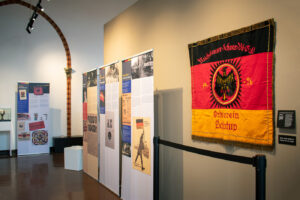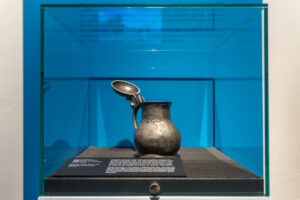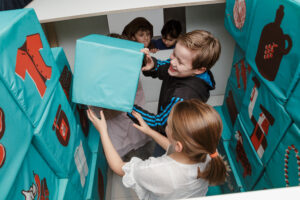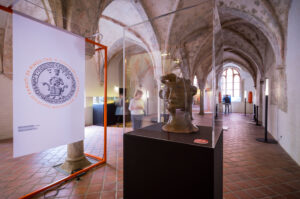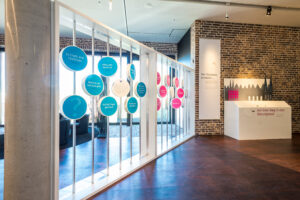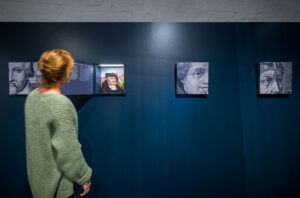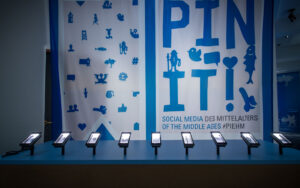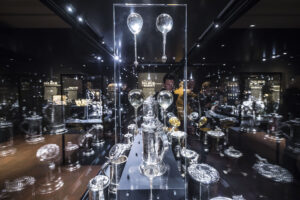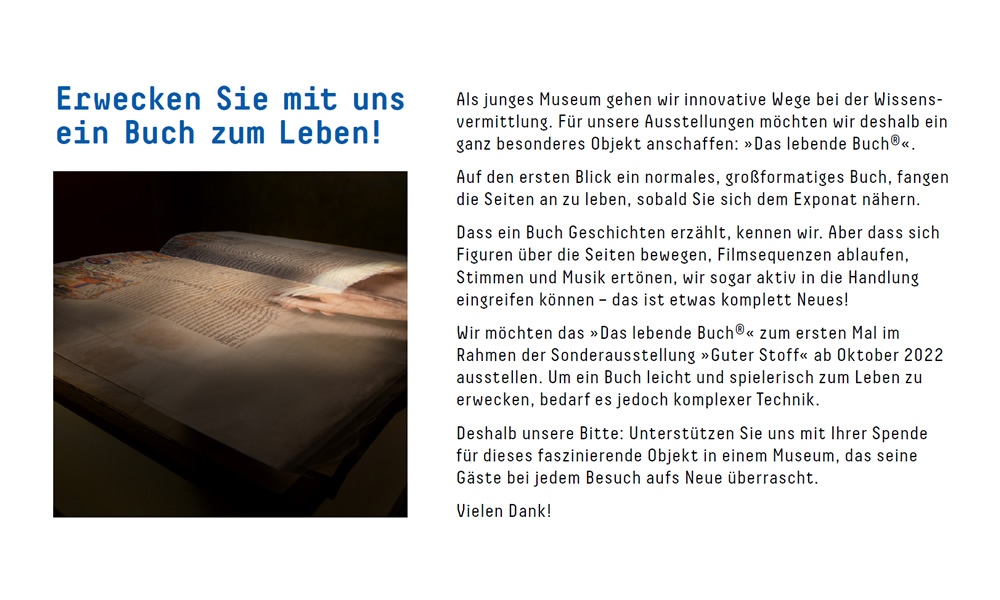Review: Past Exhibitions
2022-2023
7 October 2022 – 29 October 2023
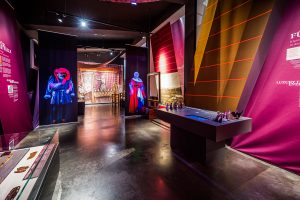 In our special exhibition »Good Stuff« we showed how textiles connect past and present societies and that sustainability was and is vital then and now.
In our special exhibition »Good Stuff« we showed how textiles connect past and present societies and that sustainability was and is vital then and now.
Textiles are everywhere in our daily lives. We wear them on our bodies, they are a symbol of belonging, but also of luxury and extravagance. Human society is and was globally interconnected through fabrics. Debates about sustainability, extravagance and waste, fair working conditions and product quality are timeless.
In our special exhibition »Good Stuff« we took a look back to the Hanse era, when the Hanse merchants traded fabrics throughout northern Europe. The textiles they bought and sold were high-quality products that brought prosperity to entire regions. We showed the profound and wide-ranging ways in which textiles affected society at the time of the Hanse.
Our exhibition also took a look at the present and future of the textile industry. How is it possible to reconcile a fair and healthy world with our needs and desires for fabrics? Is globalisation a danger for human beings and the natural world or can it also be part of the solution to our current problems?
We examined these questions in the exhibition and showed that the Hanse has more in common with the world of today and tomorrow that you might have thought.
The exhibition was under the auspices of Dr. Robert Habeck, Federal Minister for Economic Affairs and Climate Action.
2021-2022
29 May 2021 – 24 July 2022
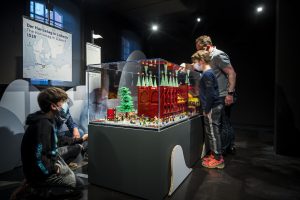
Photo: © Olaf Malzahn
In this special exhibition, the history of the Hanse was – for the first time – told with the help of LEGO bricks. A total of six Hanse worlds were carefully created in great detail by Rene Hoffmeister, one of the world’s few officially certified LEGO model makers, and his team. The size of the LEGO dioramas, which were developed on the basis of numerous scientific researches and reports, allowed insights into aspects of the merchants’ lives that have never been shown before, thanks to the smaller scale.
Explore all the rooms of this expired special exhibition, turn, zoom, view, read, linger, click… A 3D experience right here in the browser or with suitable VR glasses (Google Cardboard / Samsung Gear VR).
LEGO, the LEGO logo an the minifigure ar registered trademarks of the LEGO Group. ©2022 The LEGO Group.
2020
15 August 2020 – 1 November 2020
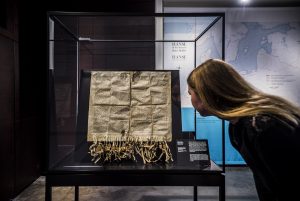
Foto: EHM/Olaf Malzahn
Stralsund was one of the most important Hanse cities in the Baltic Sea region and belonged to the Wendish group of cities. In the 14th century, Stralsund often hosted the Hansetage and was the scene of the Stralsunder Frieden / Treaty of Stralsund of May, 24th 1370 between Denmark and the Hanse. To this day, the old town contains a large number of religious and secular buildings in the Brick Gothic style typical of northern Germany at the time of the Hanse. In 2002 the city, along with Wismar, was declared a UNESCO World Heritage Site.
The exhibition focuses on two particular objects: the Peace and Privilege Treaty as well as the Compensation and Guarantee Agreement between the Hanse and Denmark. The treaty put an end to the long, warlike conflict between King Waldemar IV of Denmark and the Hanse. The merchants aim was the preservation of the Hanse trade freedoms.
Explore all rooms of this past special exhibition, turn, zoom, view, read, linger, click … A 3D experience right here in your browser or with suitable VR glasses (Google Cardboard/ Samsung Gear VR).
26 September 2019 – 26 July 2020
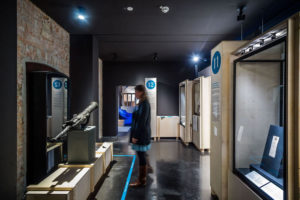
Foto: Olaf Malzahn
With this special exhibition the history of Klaus Störtebeker returned to its roots! It was first written down in the Lübeck Castle Friary in the European Hanse Museum. What better place to get to the bottom of the legend than here?
Störtebeker is said to have fought against the unscrupulous merchants of the Hanse and helped the poor. But do we know who the vitalien brethren really were? Do we also know the stories of the ›consorts‹ like Paul Beneke, Margarete Dume, Hans Pothorst or Bartholomäus Voet? Using lively historical biographies, the exhibition showed what ›piracy‹ meant in the Middle Ages.
It thus opened up a new perspective on the subject of piracy and the Hanse. The focus was on the North and Baltic Sea region between the 14th and 16th centuries.
Explore all rooms of this past (exspired) special exhibition, turn, zoom, view, read, linger, click on … A 3D experience right here in your browser or with suitable VR glasses (Google Cardboard/ Samsung Gear VR).
2019
26 May – 7 July 2019
The Reichsbanner Schwarz-Rot-Gold, was a political defence association to protect the democratic republic during the Weimar Republic. A touring exhibition of the Gedenkstätte Deutscher Widerstand (German Resistance Memorial Center) presents the Reichsbanner in the European Hansemuseum.
Some judgements about this period suggest that the disaster was inevitable: »The Weimar Republic was a democracy without democrats, its end was predestined from the beginning!« Such blanket statements, however, represent only part of the reality. Advocates and defenders of the republic, democracy and the rule of law certainly fought for their ideals. Thus the ›Reichsbanner‹ was founded as a republican, non-party veterans’ association.
More than one million former world war soldiers and many other democrats from the SPD, DDP and Zentrumspartei joined the association. Among them were the first Federal President Theodor Heuss, women’s rights activist Marie-Elisabeth Lüders and Julius Leber, member of the Reichstag. Such diverse biographies show the range of the members of the Reichsbanner and link the first German representative democracy with the one we live in today.
02 April – 02 June 2019
HanseHeroes are a format of the European Hanse Museum, which focuses on the many Hanse cities of the long Hanse history. The focus is always on a single object from the respective Hanse city.
The city of Gdansk played an important role in the Hanse for centuries. Gdansk was the intersection between Baltic Sea and Vistula trade. The main commodities traded were cereals, wax, furs, honey, hops and tar. Gdansk’s trade links extended from Portugal to Iceland, Norway and Sweden, across the Gulf of Bothnia to Finland, Novgorod, Nuremberg, Prague, Brittany and Aquitaine.
A special exhibit illustrates Gdansk’s important role in the network of Hanseatic cities. The jug was traded via the trade routes of the Hanse to Gdansk, where it got a new owner and was rediscovered by archaeologists almost 500 years later. It bears witness to Gdansk’s connection to the Hanse. The fact that it can be exhibited in the European Hanse Museum shows the current cultural ties between the former Hanseatic cities of Lübeck and Danzig.
2018
2 December 2018 – 3 March 2019
How does it feel to cross the sea under the open sky and at night on a lonely ship? The sea is enormous and unpredictable, you are afraid of sea monsters and pirates, plus the fear of losing track hopelessly. Because in the Middle Ages, neither radio nor radar were invented, sailors could only orient themselves by the stars…
In the participatory exhibition »Segel, Salz und Silberlinge«, children and their parents could explore the merchant shipping of past times. Six interactive stations were waiting to be explored – an exciting sea voyage and real adventure. The children planned their trade route, loaded the ship, sold their traded goods and thus understood how trade with foreign countries and peoples worked at the time of the Hanse: Mostly laborious and uncomfortable. A precious insight in times when supermarket shelves are always well stocked: That today’s variety of goods is a very valuable commodity.
18 September – 18 November 2018
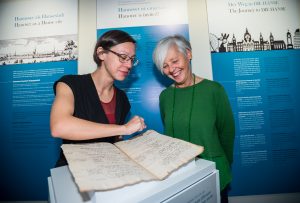
HansHeroes are a format of the European Hansemuseum, which focuses on the many Hanse cities of the long Hanse history. The focus is always on a single object from the respective Hanse city.
Our first HanseHero was a surprise. Yes, Hannover was a Hanse city! Today this part of Hannover’s history is largely unknown. The activity of the town is documented by a list from the local town archive, which lists the Hanse towns of 1556. The list was made in order to specify the procedure for invitations to the Hansetage. Discussions about this can be traced back to 1540 and continue into the 1570s. They belong to the context of the reorganisation of the Hanse cities in the first half of the 16th century.
A communication note from the city archive of Hannover states: »Hannover did not belong to the ›first league‹ of Hanse cities such as Lübeck, Hamburg, Bremen, Magdeburg or Braunschweig. Nevertheless, in the concept of the other cities, Hannover was active in the Hanse and in the regional associations of cities. Hannover owed a large part of its prosperity and its extensive political freedom of movement as an urban community over centuries to these trade connections.«
9 September 2018 – 6 January 2019
An old lady like Lübeck sure has some good stories to tell. In the course of 875 years lots of stories have come together. Thus, there was quite a lot to explore at the exhibition »875 Jahre – Lübeck erzählt uns was«. Arranged like a mosaic, hundreds of individual objects told the stories of Lübeck in two different locations.
Thus, Willy Brandt’s typewriter recounted the history of the 20th century in its own way: For it was used to write leaflets against the Nazi regime and thus indirectly helped to offer resistance. The so-called ›Apothekermumie‹ (pharmacist mummy), on the other hand, poses a riddle – what secrets does she hide?
Exhibits from each era, provided by different collections from all over Lübeck, reflecting the character of the city representative of their time. A highlight was and is of course the castle friary, which is connected to the European HanseMuseum: As the largest and walk-in museum piece, it tells the story of early urban development and the Danish period in the early 13th century. Listen closely to the stories, the Dominican convent is telling us.
10 May – 8 July 2018
By what verbal means do opposing positions also find each other? In the exhibition »Consensus. Europe’s Culture of Political Decision Making« which ran in our institution in early summer 2018, we traced this topic: It was astonishing to find that some of today’s mechanisms were already known in the time of the Hanse, for example to convince hesitant delegates. In those days there were friendly conversations, serious admonitions, secret talks in the listening chamber or the invocation of a mediator – with the aim of unity, friendly and fraternal cooperation (togetherness).
And look at that: There seems to be a tradition of unanimous decision-making, as found at both the Hansetage and the Council of European Heads of State and Government. In this way, visitors learned what good reasons there are for the often difficult negotiations to reach a consensus and why all parties involved hope that this will give them greater political clout – and the small ones greater protection from the big ones. But how does such a decision making process work in practice?
2017
8 September 2017 – 26 November 2017
Even the sale of indulgences at the beginning of the 16th century was famously about money. While the faithful wanted to buy themselves free of their sins, the Roman Church and numerous princes rubbed their hands in the face of the enormous revenues. With the Reformation, the dispute over the valuable property of the church began, and this was bitterly fought between the Protestant and Catholic camps, especially in Germany.
Reformation and European Reality
In the exhibition “Money. Power. Faith. Reformation and Economic Life” in autumn 2017, we have dedicated ourselves to questions about the European perspective, because the continent experienced numerous reformations and religious refugees were a European reality at an early stage. These flight movements in turn changed the economic world. At the same time, the schism marked the beginning of religious tolerance in Europe: Because the more tolerant a country is, the better for its economic development. An understanding that is still relevant today.
19 May 2017 – 6 August 2017
We wanted to find an answer to this question – with the 2017 special exhibition »Pin it! Social Media of the Middle Ages #PIEHM«. We compared medieval badges with symbols of today’s digital communication culture, the emojis. And researched the centuries-old lead-tin alloy badges, which range in their depictions from the highly sacred to the crudely obscene. Especially male and female genitals with wings, beards and legs left us and our visitors amazed because of their directness.
It seemed astonishing that in the Middle Ages these signs, which were inexpensive to produce, were worn on the clothing of all classes of the population in Western Europe – a kind of first pictorial mass medium in Western Europe?
More than 250 badges from the 14th to 16th centuries were shown in our house, and for the first time in Germany. An interactive photo box for dressing up, two art installations and a magnetic wall for new and old symbols formed the link to the present. As well as encouraging visitors to publish a post on social media themselves.
7 December 2016 – 26 February 2017
Did you know how Spanish conquistadors in South America recovered the shining treasures with the help of modern mines? And how they exploited the indigenous population of the continent by brutal means? At that time, the precious metal dominated the world market as a commodity and means of currency until the abundance led to the first inflation – an aspect that is particularly interesting in today’s world trade.
In the special exhibition »Silver´s Shine and Silver Greed«, which ran in our house in the winter of 2016/2017, high-quality silver objects from the 16th to 18th centuries from the KODE Art Museums in Bergen were on display outside Norway for the first time – the famous silver treasure from Bergen. For the skilled goldsmiths crafted true masterpieces from the precious metal with special patterns on crowns, cups and silverware. It is precisely these details that indicate the different epochs of their creation.
And today? Silver has become an almost everyday material, widely used in jewellery and technology. A significant perspective that we have also illuminated in the exhibition.
